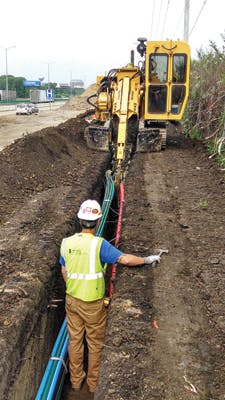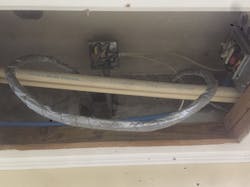An updated model specification for high-density polyethylene (HDPE) conduit has been published by the Plastics Pipe Institute, Inc. (PPI), a trade association representing all segments of the plastic pipe industry. Available for free on PPI’s website, document MS-5, “Model Specification for HDPE Solid Wall Conduit for Power and Communications Applications,” assists specifiers in preparing specifications for an HDPE conduit project. Prepared with input from PPI members who are industry experts, the updated MS-5 document provides specifiers with a starting point in developing final specifications for a particular project’s needs. It includes reference to various product specifications by standard-development organizations (SDOs) such as ASTM, CSA, NEMA, and UL, and describes when and how to use these industry documents. “Industry standards for conduit, such as ASTM F2160 and D3485, NEMA TC7, and UL 651A and 1990, have all been updated since 2016, including changes to product performance,” notes Lance MacNevin, PE, director of engineering for PPI’s power and communications division. He adds, “Conduit specifications have been specifically developed for the demands of telecom, power, utility, aerial or underground applications. An inaccurate or an out-of-date product specification can cause confusion among suppliers or result in an inadequate product being installed.”
Familiarity with the updated HDPE conduit spec will benefit OSP project planners.
According to PPI, while HDPE conduit and pressure pipe specifications may appear similar, there are technical differences that are critical to achieving the intended performance of products in specific applications. HDPE conduit, including cable in conduit (CIC), is widely used in trenching, horizontal directional drilling (HDD) and plowing installation methods, and is the preferred material to house and protect electrical power and communications cables in typical applications such as: power utilities; telecommunications; CATV; SCADA; FTTH; ITS; highway lighting; and other underground utilities. Benefits of HDPE conduit, according to PPI, include: availability in long lengths without joints; high strength; flexibility; proven reliability; and installation toughness. Tony Radoszewski, CAE, PPI president, comments, “Major telecom firms should be certain their specifications are updated to match the latest industry standards. Specifying an incorrect standard for HDPE conduit can delay projects, increase costs, or result in an inappropriate material selection. This new model specification is written to help specifiers avoid those problems.”
The MS-5 specification is available free and can be found on PPI’s website. The direct link to MS-5 as published online is: https://plasticpipe.org/pdf/ms-5-conduit.pdf. Complementary to the MS-5 spec, a recently updated PPI document, Technical Note 50 (TN-50), “Guide to Specifying HDPE Conduit,” that advises specifiers on selecting the right type of conduit for various types of projects, has also been released.
Must-See Photos:
Tape the money and run
J.N., director of IT for a resort and casino located in the U.S. Virgin Islands, sent us this classic cable-fail shot, with caption, “If you run out of conduit, just wrap the rest of the 15-foot bundle in duct tape. There are four Cat 5e cables in there.”Send your must-see cabling photos to mattv@pennwell.com


